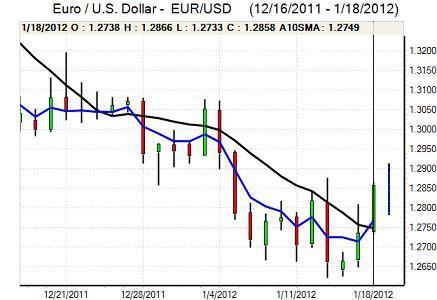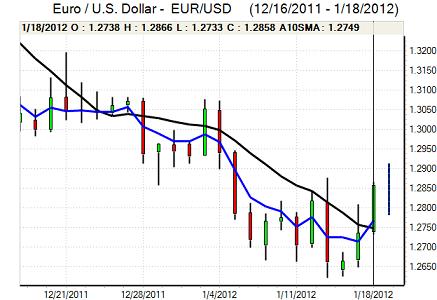EUR/USD
The Euro found support in the 1.2750 region against the dollar on Wednesday and challenged resistance levels above 1.28 as there was further pressure for a covering of short positions given the huge positioning bias in favour of Euro selling.
There were reports that the IMF was seeking additional funds to bolster its defences against the Euro-zone crisis. After some initial confusion surrounding amounts, the IMF suggested that it would look to increase funding by an additional US$600bn which would take the total commitment to USD1.0trn. There was, however, no indication of how these funds would be sourced, especially with US opposition to any increase in its contribution.
There was a rise in Portuguese yields to record highs which increased speculation that it could eventually default. There was also further uncertainty surrounding the Greek situation with no immediate deal as talks with creditors resumed, but participants are looking for a deal by the end of this week.
The US growth-orientated data did not have a major impact during the session with industrial production rising by 0.4% for December after a revised 0.3% decline for the previous month while capacity usage nudged higher. Headline producer prices fell 0.1% for the month while underlying prices rose 0.3% and the monetary implications are limited.
The latest Treasury flows data recorded an increase in long-term inflows into the US which provided some relief, although Chinese holdings continued to decline.
There was a general improvement in risk appetite as fear surrounding the global outlook eased slightly and this was important in curbing demand for the US dollar on defensive grounds. The Euro continued to dip sharply at times, but there were further net gains and the currency pushed to test resistance above 1.2850 in Asian trading on Thursday.

Source: VantagePoint Intermarket Analysis Software
Call now and you will be provided with FREE recent forecasts
that are up to 86% accurate* 800-732-5407
If you would rather have the recent forecasts sent to you, please go here
Yen
The dollar found support in the 76.65 area against the yen during Wednesday and moved higher during US trading, although it was again blocked below resistance in the 77 area.
There were no major domestic developments during the day with a continued focus on the yen crosses. There was an improvement in risk appetite which helped maintain pressure for a yen correction weaker following recent gains and the Euro pushed to a two-week high near 98.80 while Sterling also gained ground.
The yen was still broadly resilient given that risk appetite was generally firmer and there was still a reluctance to sell the currency aggressively, especially with Euro-zone fears persisting.
Sterling
Sterling found support in the 1.5350 area against the dollar on Wednesday and strengthened to a high in the 1.5440 area as the US currency was subjected to wider losses while the Euro held above the 0.8320 area.
The latest unemployment claimant count was again better than expected with the increase for December held to 1,200 after a revised 200 increase the previous month. The unemployment data was less favourable as there was an increase to a 16-year high of 8.4% from 8.3% and youth unemployment continued to increase.
Elsewhere, the Nationwide consumer confidence index fell to 38 for December from 40 previously and this was the second lowest figure on record. There were further expectations that the Bank of England would move towards additional quantitative easing at one of the next two meetings given fears over weak spending and lending.
There was further evidence of overseas demand for UK bonds as the yield on benchmark bonds fell to fresh record lows near 1.90%.
Swiss franc
The dollar was unable to gain any fresh traction on Wednesday and dipped to test support below the 0.94 level. Principal interest focussed on the crosses as the Euro briefly spiked higher to the 1.2130 area before sliding back to 1.2080. There was immediate speculation over intervention, but there was strong evidence that the move was due to a mis-quoting of rates and there was no evidence of open intervention by the National Bank.
The ZEW business confidence index improved to -50.1 for December from -72 previously which maintained some degree of optimism that the economy could register some net improvement, but pressure for a higher Euro minimum rate will continue.

Source: VantagePoint Intermarket Analysis Software
Call now and you will be provided with FREE recent forecasts
that are up to 86% accurate* 800-732-5407
If you would rather have the recent forecasts sent to you, please go here
Australian dollar
The Australian dollar again looked to take advantage of US vulnerability during Wednesday and pushed to highs around 1.0440, but it did have difficulty in sustaining the gains.
The latest employment data was substantially worse than expected with a headline decline of 29,300 for December compared with expectations of a 10,000 increase, although the unemployment rate did decline to 5.2% from 5.3% previously. The employment data pushed the currency sharply weaker, although it was able to find buying support above 1.0350 with some evidence of longer-term buying support as risk appetite held firm.



